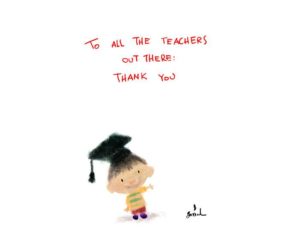An Apple for the Teacher, and the Students.
Description
 It’s graduation time again so we turn our attention to education once more. In this short interview, Ms. Vivian shares her experience as an instructor of international students in a department owned by a private corporation at a major public university in the United States of America. She describes being restricted from modifying the curriculum to suit the needs of her students. She supposes that standardization of the material is a way of creating a uniform product for delivery across multiple classrooms and institutions. It also decreases the amount of preparation time for teachers, thereby allowing the company to require instructors to attend to more classes, which allows them to hire fewer teachers. This approach completely discounts people as individual learners, discredits the creativity and integrity of instructors, ultimately disempowering students and teachers alike.
It’s graduation time again so we turn our attention to education once more. In this short interview, Ms. Vivian shares her experience as an instructor of international students in a department owned by a private corporation at a major public university in the United States of America. She describes being restricted from modifying the curriculum to suit the needs of her students. She supposes that standardization of the material is a way of creating a uniform product for delivery across multiple classrooms and institutions. It also decreases the amount of preparation time for teachers, thereby allowing the company to require instructors to attend to more classes, which allows them to hire fewer teachers. This approach completely discounts people as individual learners, discredits the creativity and integrity of instructors, ultimately disempowering students and teachers alike.
This line of thinking is also found in the standardized practice of medicine. Even though each individual has a different set of circumstances and needs, treatment protocols are becoming algorithmic and medico-legal standards of care such that deviations tailored for the individual needs of the patient, or enhanced by the knowledge, skills, and experience of the physician are discouraged.
What we are talking about here is the institutionalization, industrialization, standardization of life on planet earth. There are certainly  benefits to uniform standards of performance of critical skills conferring reliability and accountability. However, when it comes to education, an open, exploring mind encourages creativity, innovation, and fulfillment. And, when it comes to healing there are many paths to becoming whole again. The growth, development, and health of individuals and society depends on actually not having uniformity and conformity.
benefits to uniform standards of performance of critical skills conferring reliability and accountability. However, when it comes to education, an open, exploring mind encourages creativity, innovation, and fulfillment. And, when it comes to healing there are many paths to becoming whole again. The growth, development, and health of individuals and society depends on actually not having uniformity and conformity.
Market forces and commercial values have insinuated themselves into life either causing, or because of, a massive cultural shift in society. Students have become “consumers”, education is now a “product”, just like patients are now “clients”, physicians are “providers”, and the practice of medicine is a part of the “service industry”. Universities, private schools, and medical institutions now spend gobs of resources on marketing and recruiting clients/consumers. Marketing in the medical profession is a relatively recent phenomenon. Direct-to-consumer advertising of pharmaceuticals has only been legal since 1985. Prior to 1977 it was against the rules for doctors and hospitals to advertise. Medicine, and education were considered professions inspired by a call to duty, not a business. Even now, many older, experienced physicians find the marketing of medicine distasteful, even unprofessional. The marketing inroads in higher education involve universities routinely “branding” themselves in order to boost enrollment, particularly from out-of-state students who pay higher tuition fees. The costs of “high quality” medical care and a “good” education are ballooning disproportionately to the gain in actual value. We are all paying more for less.
In order to maximize profits medicine and education are also turning to using the internet to sell their “products and services”. Even as there are advantages and disadvantages to online learning and virtual medical consultations, as a teacher and a physician I can attest to knowing it is a huge loss to not be able to smell the patient or to see the light turn on or off in a student’s eye.
 The financial incentives for corporate support of public educational institutions are apparent. Ms. Vivian describes the dazzle and glitz of the classrooms funded by Apple, Inc. Each student, as well as every teacher, is provided with an Apple computer. It’s a great way to familiarize young users with a branded product so they will become loyal customers in the future. It’s a marketing strategy with a high return on investment for the company, as if return on investment is the purpose of education. The public institution, starving for funds, due to the reluctance of Americans to pay taxes, are happy to accept the backing of these flush corporations. It looks like a win-win solution on the face of it.
The financial incentives for corporate support of public educational institutions are apparent. Ms. Vivian describes the dazzle and glitz of the classrooms funded by Apple, Inc. Each student, as well as every teacher, is provided with an Apple computer. It’s a great way to familiarize young users with a branded product so they will become loyal customers in the future. It’s a marketing strategy with a high return on investment for the company, as if return on investment is the purpose of education. The public institution, starving for funds, due to the reluctance of Americans to pay taxes, are happy to accept the backing of these flush corporations. It looks like a win-win solution on the face of it.
The conversation is more complex that it appears at first glance. According to the American Council on Education:
Despite steadily growing student demand for higher education since the mid-1970s, state fiscal investment in higher education has been in retreat in the states since about 1980. In fact, it is headed for zero. Based on the trends since 1980, average state fiscal support for higher education will reach zero by 2059, although it could happen much sooner in some states and later in others. Public higher education is gradually being privatized……If these public institutions are no longer state supported who owns them? Who should govern them? Who should they serve? Should states be contracting for quite specified outcomes? The defunding of public higher education by the states inevitably inaugurates a new conversation about who controls them and whose interests are to be served. The states will play a diminished role in finding answers to these questions if public higher education is to survive and thrive.
Education does a public good, benefiting all members of society, including the uneducated. Similarly, a healthy individual improves the health of the herd in terms ranging from infectious diseases to mental health. Non-profit public educational and health care institutions used to be two of America’s greatest cultural assets. If you got run over by a truck you can better believe you wanted to be transported to your nearest county hospital where





